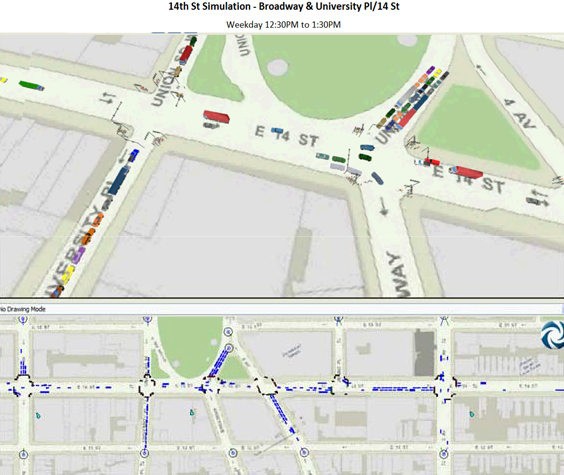 NYCDOT was seeking a demonstration of innovative simulation modeling tools and techniques pertaining to pedestrian‐vehicle interactions utilizing commercial over‐the‐ counter application(s) and/or customized software of 14th Street in Manhattan between 5th and 2nd Avenues using standard input data provided by NYCDOT.
NYCDOT was seeking a demonstration of innovative simulation modeling tools and techniques pertaining to pedestrian‐vehicle interactions utilizing commercial over‐the‐ counter application(s) and/or customized software of 14th Street in Manhattan between 5th and 2nd Avenues using standard input data provided by NYCDOT.
As part of this effort KLD created a model using the data provided by NYCDOT using the Aimsun traffic simulation model tool.
The 14th Street corridor is a saturated environment with respect to vehicle‐pedestrian interactions, especially around the Union Square area. The field data provided by NYCDOT and site visits suggest that the critical elements with regard to modeling the vehicle pedestrian interaction would be the representation of the “permitted” left turn movements, and the right turn movements. The above two sets of movements tended to be at the end of each signal cycle, and were of a different behavior pattern (“sneakers”) compared of vehicles along the through movement. This implied that the modeling had to pay special attention to the signal clearance intervals. Taking this into account, the number of vehicles that discharged per hour was converted to per signal cycle basis and the simulation was calibrated to achieve a comparable number of movements. This ensured vehicles making these movements (i.e., the movements that were most affected by pedestrian interaction) were represented accurately. The turn movements were captured with an R‐squared of 0.99 for both trucks and cars, with GEH less than 5 for all but one movement (a thru movement with a GEH of 5.1). The average speed in the simulation was generally within the range of the observed samples in the field.
The key conclusion from this modeling effort was the representation of the traffic conditions in the clearance intervals was critical to building a model to represent vehicle pedestrian interactions along this corridor accurately.